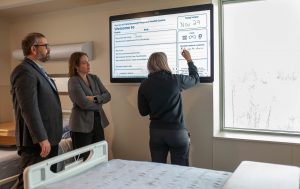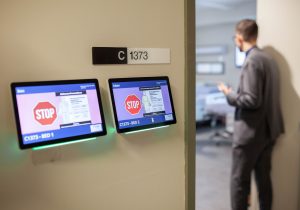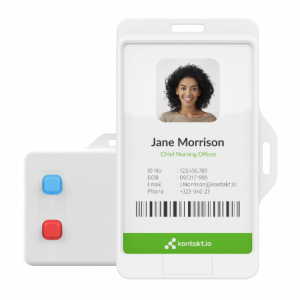“You go there, and you see sunshine…”
Paul is recalling the treatment he got at the local hospital.
He speaks both literally and figuratively, and it’s clear he both enjoyed and benefited from his stay.
He was one of the earliest patients at the new Reactivation Care Centre at Peterborough Regional Health Centre (PRHC) in Ontario, where patients get ready to head home once they no longer require acute, hospital-level attention.
The space has a dedicated interdisciplinary health care team, and an integrated technology system that represents a new model for patient transitional care. PRHC and global technology company Cisco are partners on the project to deliver technology solutions for the Centre and support for patients as they transition from hospital to home.
The period following hospital discharge is so important for a patient’s regaining strength, and for preventing potential health complications.
But it’s not just a matter of a patient’s medical recovery; it’s about a person establishing his or her independent lifestyle as much as possible, considering all the individual physical, emotional, social, even vocational factors at play. Reactivation care following a hospital stay is an important factor in full and fulfilling outcomes for all of us, particularly for older adults.

To build a bridge from hospital to home, the Reactivation Care Centre makes use of different smart wearable technologies, integrated communications and conferencing systems. PRHC image.
To build that bridge from hospital to home, the Reactivation Care Centre makes use of different smart wearable technologies, integrated communications and conferencing systems, and AI-powered data analytics. Digital devices like Corsano Cardio Bands, Webex platforms, Cisco Spaces and Kontakt.io Badges are in the mix.
The Reactivation Care Centre team, and the technology used, helps patients and their families during a time-specified, short-stay admission: the goal is to get each patient as independent and active as possible so their discharge from the hospital is successful and they can safely transition back into the community.
By combining individualized treatment programs, different clinical disciplines, and the latest digital innovations, PRHC and Cisco are demonstrating how health systems can evolve to meet the complex and diverse needs of patients leaving acute care. While all are eligible, the Centre is focused on seniors.
The project was made possible by Cisco’s Country Digital Acceleration (CDA) program, which helps many kinds of organizations accelerate their digital transformation by providing technology, expertise, funding and partnerships.
“We’ve worked in the hospital space as a tech partner,” says Wayne Cuervo, Director of Cisco Canada’s Digital Impact Office. “We look to help solve novel and unique challenges with technology and investment. Working with our partners, technology can help solve problems, but there may be a need for some kick-start money to validate and integrate the concept.
“This is not a one-off, it is a replicable solution,” he adds, noting how real-time collaboration tools can provide clinical insights and operational benefits at other institutions. “Our partnership with PRHC demonstrates how technology can transform healthcare delivery, improve patient outcomes, and set a new standard for recovery across Canada.”

Information sharing, real-time communication and collaboration among care teams, patients, and families is supported by new technology. PRHC image.
The Centre in Peterborough is now equipped with an integrated suite of smart technology tools that include Webex Boards for real-time communication and collaboration among care teams, patients, and families. The all-in-one devices convey audio, video, whiteboard notations and more, with Cisco Webex Room Navigators used to view contact information, launch a meeting, share content, end a call and more from a touchscreen.
Patients can see the difference good communications and open schedules can have, as Paul described, adding he was happy to be tracked during his reactivation process.

Important patient information is digitally available, with health charts and records integration connected and available throughout the Reactivation Care Centre. PRHC image.
“They all engage with the patient more. People come in, they introduce themselves right away. The doctor’s in once a day, and things are explained, we talk about progress being made,” he recalls. “I had to do some walking as part of my physio. The Centre is built like a circle, and I know how many steps in each lap. I was able to make my target on the third day!”

Location-based devices and platforms like Cisco Spaces can track and manage other IoT devices, while Kontakt.io Smart Badges can be used for patient and staff safety, providing features like duress alerts and location tracking.
Wearable devices can be used to track patient mobility and monitor vital signs, offering real-time insights into the recovery progress. Cardio bands, watches, or bracelets from Corsano track the wearer’s pulse rate, respiration rate and other parameters like core body temperature, all of which are used to improve clinical outcomes, and enhance patient experience.
Cisco and Corsano are health care technology collaborators, and they recently showcased the new Cisco Platform for In-Hospital Monitoring. Using the Corsano bracelet, patient vital signs were streamed live over low-power Bluetooth BLE to Cisco’s latest router and into a hospital’s IT system.
In fact, PRHC recently launched its new hospital-wide, custom-built, data analytics platform designed to enhance patient care and streamline hospital operations through real-time data insights.
Called Peregrine, the platform is built on Microsoft Fabric for secure data collection and analysis. By providing instant access to curated data, the system supports hospital decision-making and quality improvement initiatives.
The development of Peregrine was supported by Hitachi Canada, and it was a key component of the PRHC 2024-2029 Strategic Plan, with its priorities of data, analytics, and technology.
Brendan Sova, the Manager of Reactivation Care Centre, has seen the positive impact those priorities have on patient outcomes and Centre operations.
“The support we can give (to patients) at the front end is paying dividends on the back end,” he says. “There are fewer re-presentations from patients; they’re staying for shorter periods. It’s been a game-changer for us, catching and using the data in real time to be able to drive the best outcome and get patients back home. Important information is now digitally available, with health charts and records integration and everything connected and talking. There’s a single source of truth, and we can push the info from source to need. Everything is automatically updated, so individual team members can have more time with patients.”
Paul, the now-former patient (who acknowledged being “way past 65”), had suffered through two bouts of pneumonia when he was first admitted into the new Centre. It made an impact on him that he still remembers:
“Comparing before to the new unit is like night and day. Like sunshine coming in. You go there and see sunshine.”
Then you get to go home and enjoy it even more.
-30-

Peterborough Regional Health Centre (PRHC) is the region’s largest employer, with more than 3,100 staff, 450 physicians with privileges and a core group of 250 volunteers delivering acute healthcare to a rapidly growing population of more than 300,000 in Peterborough and the surrounding communities, including the First Nations of Curve Lake, Alderville and Hiawatha. PRHC (CNW Group/Cisco) image.



